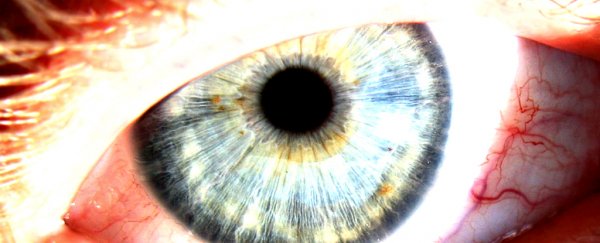Our eyes might be more awesome than we ever imagined.
A new experiment has shown for the first time that the human eye is capable of detecting the smallest units of light - called photons - under super-dark conditions.
That means our eyes are able to actually sense individual particles… which is pretty crazy, seeing as it's something that high-tech machines struggle to do.
"If you imagine this, it is remarkable: a photon, the smallest physical entity with quantum properties of which light consists, is interacting with a biological system consisting of billions of cells, all in a warm and wet environment," said lead researcher Alipasha Vaziri from Rockefeller University.
"The response that the photon generates survives all the way to the level of our awareness despite the ubiquitous background noise. Any man-made detector would need to be cooled and isolated from noise to behave the same way."
The cells in our eye that detect light are called rod cells, and these are known to become more sensitive in the dark. There are about 120 million of them in our eyes - compared to around 6 million cone cells, which are the cells that detect colour.
So, in other words, our eyes have the potential to be highly sensitive to light, but they're usually so stimulated that we haven't really been able to test their limits.
In landmark experiments in the '40s, researchers had shown that human subjects whose eyes had become used to the dark were able to detect flashes of five to seven photons at a time.
But no one had been able to determine whether or not we could detect individual photons, seeing as it's so hard to create a set-up that delivers only one photon at a time.
In the latest study, the Rockefeller University team joined forces with researchers from the University of Vienna in Austria, who were able to build a device that does just that - it can either send one photon at a time to a person's eye, or nothing at all.
They then took three men, aged in their 20s and made them collectively sit through more than 30,000 rounds of this photon-delivering device. One of the participants was wearing contact lenses.
In each test, the men sat in a dark, sound- and light-insulated room, wearing headphones. Their heads were stabilised on a headrest, and they were each asked to fix their right eye on a dull, red light.
The men were then shown two light stimuli from the machine. One where a single photon was fired into the part of their retina with the most rod cells, and another where the device was totally dark.
The participants had to say which of the two had delivered the photon - something they could 'sense' rather than 'see', according to Vaziri, who tried the device himself.
"The most amazing thing is that it's not like seeing light," he told Nature in an editorial accompanying the paper. "It's almost a feeling, at the threshold of imagination."
After making their prediction, the three men were told via their headphones if they were right or wrong, and they were then given another test… over and over again.
Over the course of more than 30,000 tests, the men were able to correctly detect the photon 51.6 percent of the time. That doesn't sound like a lot, but statistically speaking, it's a higher accuracy rate than chance, which tells the researchers that the men were able to accurately detect the photons at least some of the time.
The team also showed that the men were much more likely to detect a photon if a second photon was flashed a few seconds earlier - they had a 56 percent success rate if a photon has flashed within 10 seconds of an earlier one - which suggests that one photon essentially 'primes' the system to register the next.
While it's a fascinating result, the researchers now need to verify their findings with a larger sample size, to confirm that the participants really are capable of detecting the individual photons.
The fact that the men in this trial were told after each test whether they were right or not could also have influenced the results and helped them somehow learn to figure out whether a photon was fired through some other means - so in future experiments, the experimental procedure might need to be tweaked.
"The only thing that I am sceptical about is that only three individuals have been tested," Leonid Krivitskiy, a physicist at the Agency for Science Technology and Research in Singapore, who wasn't involved in the study, told Nature. He added that females need to be tested too before we can say for sure that humans are detecting individual photons.
But, if verified, the discovery would open up a whole new set of questions for scientists - namely, how are our eyes able to detect such tiny units of light, and how can we learn from their structure to make artificial detectors more accurate?
"What we want to know next is how does a biological system achieve such sensitivity? How does it achieve this in the presence of noise?" said Vaziri. "Is the mechanism unique to vision or could it tell us something more general on how other systems could have evolved to detect weak signals in the presence of noise?"
His team is now planning to test how our visual system responds to photons in various quantum states, which could open up a whole new world of quantum detection.
The research has been published in Nature Communications.
